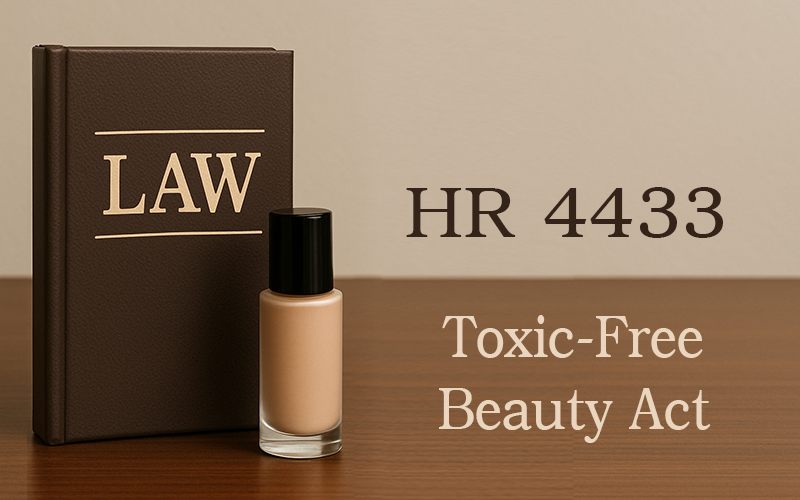The first bill included in the Safer Beauty Bill Package is H.R. 4433 – The Toxic-Free Beauty Act introduced by Reps. Schakowsky and Fletcher.
Along with some other new definitions, it would add a new definition to the Food, Drug, and Cosmetic Act of a “Color Cosmetic,” which would be defined as “a cosmetic that either enhances or conceals natural pigment of an individual’s skin by applying color, including eyeshadow, eyeliner, blush, lipstick, and foundation.”
However, the primary purpose of this bill is to ban 18 of the most toxic chemicals and two whole classes of chemicals (phthalates and formaldehyde releasing preservatives) from being intentionally added to cosmetics.
View the list of chemicals
- Any intentionally added ortho-phthalate or formaldehyde-releasing preservative.
- Formaldehyde (CAS No. 50–00–0).
- Methylene glycol (CAS No. 463–57–0).
- Mercury and mercury compounds (CAS No. 7439–97–6).
- Isobutylparaben (CAS No. 4247–02–3).
- Isopropylparaben (CAS No. 4191–73–5).
- M-Phenylenediamine (including the salts of such substance) (CAS No. 108–45–2).
- O-Phenylenediamine (including the salts of such substance) (CAS No. 95–54–5).
- Lilial (CAS No. 7439–97–6).
- Styrene (CAS No. 100–42–5).
- Toluene (CAS No. 108–88–3).
- Triclosan (CAS No. 3380–34–5).
- Triclocarban (CAS No. 101–20–2).
- Cyclotetrasiloxane (CAS No. 556–67–2).
- Acetaldehyde (CAS No. 75–07–0).
- Vinyl acetate (CAS No. 108–05–4).
- 1,4 dioxane (CAS No. 14807–96–6) present at or above 2 parts per million (referred to in this paragraph as ‘ppm’).
- Lead and lead compounds (CAS No. 7439–92–1) present at or above 2 ppm for color cosmetics or 5 ppm for general cosmetics.
- Asbestos or asbestos containing compounds, including asbestos-contaminated talc (present at the lowest possible limit of detection).
In reality, few (if any) of these ingredients are currently in use, and definitely not by small businesses or handcrafters making cosmetic products. Most have already been acknowledged as unsafe.
These ingredients have already been banned by the European Union and a number of states, including California, Maryland, Oregon, Washington, and Vermont. There are other states that have bills in progress to bans some or all of these ingredients as well.
A note about parabens
Some articles I’ve seen about this bill say that it “bans parabens.”
In actual fact, it only bans isobutylparaben and isopropylparaben, which have already been banned in the EU for nearly 10 years and have therefore fallen out of favor for use in preservatives.
There are other parabens that are still widely used in preservatives and are considered safe and reliable. Germaben II, commonly used by small businesses and handcrafters, contains methylparaben and propylparaben, both of which are considered safe enough to use in food.
Why it Matters
This bill may have an impact on any companies that continue to use these ingredients in the US. However, since these ingredients are already banned in some states and are likely to be banned in more, they are mostly or completely already phased out.
This bill should have no real impact on small businesses or handcrafted cosmetic makers.
One factor that may impact you is the consumer perception of the use of parabens. If news outlets and other media continue to make broad generalizations about the parabens that are on the ban list, you might get questions or push-back from consumers about the use of any parabens in your products–even if the bill never passes. To prepare for that possibility, if you use Germaben or other paraben-containing preservatives, prepare yourself to be able to effectively respond to consumers with concerns.
Timeframe
IF, and that’s a big if, this bill is passed, it would go into effect on January 1, 2027.
There are still many steps and approvals needed before this bill winds up on the President’s desk for signature. The bulk of all bills introduced never make it. This one may have a chance, since it’s dealing with chemicals and ingredients that are already banned in the EU and some states, but it’s still got a very long runway.
So far, it has only been referred to the House Committee on Energy and Commerce.


Leave a Reply